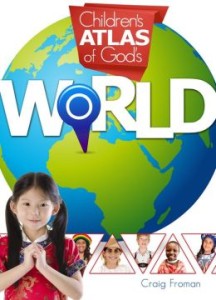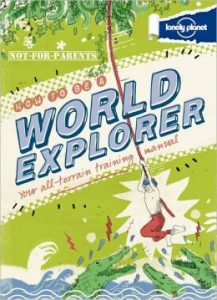Geography, like Grammar (and God), is a neglected subject in today’s public school system. Too bad—I well recall my  sixth grade teacher Mrs. Nelson, a world traveler whose students generally caught her enthusiasm for foreign places and people. Though I did no serious traveling until my children were grown, I’ve always liked maps—not the kind you have to refold while driving 60 mph down the Interstate, but the kind that comes in books. The Atlas, that is, named for the Greek demi-god sentenced to hold up the world on his shoulders. Tough luck for him, but a good modern-day Atlas holds up the world cheerfully, inviting readers to pore over its pages and dream of all the places they’d like to see someday.
sixth grade teacher Mrs. Nelson, a world traveler whose students generally caught her enthusiasm for foreign places and people. Though I did no serious traveling until my children were grown, I’ve always liked maps—not the kind you have to refold while driving 60 mph down the Interstate, but the kind that comes in books. The Atlas, that is, named for the Greek demi-god sentenced to hold up the world on his shoulders. Tough luck for him, but a good modern-day Atlas holds up the world cheerfully, inviting readers to pore over its pages and dream of all the places they’d like to see someday.
Children’s Atlas of God’s World, by Craig Foreman. New Leaf Publishing Group, 2013, 96 pages. Age/interest level: 6-up.
“This is my Father’s world,” we sing in church, and New Leaf’s new Atlas was produced to bring that principle home. Though not comprehensive, this oversize (13 ¾” X 10”), full-color, handsomely-bound volume is designed for handy reference and leisurely browsing. “Not comprehensive,” that is, in the sense that not every nation on earth is covered, unlike Lonely Planet’s Not-for-Parents Travel Book. But, also unlike the Travel Book, there’s a better sense of proportion and priority—like it all means something besides a glorious hodge-podge.
“In the beginning God created the heavens and the earth” (Genesis 1:1). This powerful verse written by Moses begins God’s Word . . . the Bible. Here in Genesis we come to know that God made everything, including us, and that we can know that the world is no mere accident or caused by a random explosion in the universe. Our world was planned by Him, and we’re part of His great plan. Because we are all descendants of Adam and Eve, on earth there is really only one race of people . . . the human race.
From this perspective, we turn to our home continent, North America, with separate chapters on the United States, Mexico, and Canada. Countries as diverse as Grenada, Guatemala, and Greenland are also considered part of North America, but the Atlas limits its focus to 2-6 nations within each continent, determined by size, historical significance, or influence in the modern world. Only two nations in South America are spotlighted, and three in Africa, but six each in Europe and Asia. However, an overview for each continent lists all the countries and explains the outstanding geographical features and selected points of interest. More importantly, blue flags throughout the text mark places and people of significance to Christian history.
In addition, green pennants note UNESCO (United Nations Educational, Scientific, and Cultural Organization) “World Heritage” sites, which can be looked up online. A section on Biomes (an awkward nickname for “biological homes”) explains the various geological habitats that appear throughout the Atlas: Desert, Rain Forest, Coral Reefs, Grasslands, etc. The appendix includes a glossary, a list of governmental systems (accompanied by I Tim. 2:1-2), Holidays around the world, and a full index.
The text is adequate though sometimes disjointed (some abrupt transitions between paragraphs, for example), but the presentation is attractive and eminently browse-worthy.
- Worldview/moral value: 5
- Literary value: 3.5
 Not for Parents: How to be a World Explorer: Your All-Terrain Training Manual, by Lonely Planet. Weldon Owen LTD, 2012, 159 pages, including index. Age/interest level: 9-up.
Not for Parents: How to be a World Explorer: Your All-Terrain Training Manual, by Lonely Planet. Weldon Owen LTD, 2012, 159 pages, including index. Age/interest level: 9-up.
Lonely Planet Guide Saves Lives of Three Boys, read the eye-catching headline in Publishers Weekly last spring. While on vacation with their families in Queensland (Australia), the boys wandered off to explore and found themselves literally trapped in quicksand. Fortunately, one of them had received the How to Be a World Explorer book for Christmas, and had evidently poured over its pages like I suspect many a 9-year-old boy would. So he knew that the best way to escape quicksand was to lean back, pull his feet up through the bog and stretch out on the surface, distributing his weight. He was able to paddle out and run back for help for his two companions.
It’s not often that a book physically saves a life, but this one could do exactly that many times over if the hypothetical situations are ever actually encountered by its young readers. My plan was to skim through it so I could tell you what was in it (unlike certain high-profile bills passed by Congress) but it didn’t work out that way. Whoa—here’s how you can safely remove a leech from your leg! And how to wrestle a crocodile? Cool! And you never know when you’ll have to tame a camel or survive an elephant attack. What kind of wild food can you safely eat in the forest? (General field guide shows you what to look for.) How do you save yourself from quicksand? (Already learned that one).
The material is organized in six geological habitats: Jungle & Savanna, Desert, Polar, Forest & Mountain, Oceans & Rivers, and Air. In each chapter we learn some geography, history (e.g., the Shackleton and Livingstone expeditions), practical skills (such as basic navigation), extreme first aid (ever wonder how to replace an eyeball that popped out of your head?). You’ll also learn emergency uses for urine. Yes, the book is a little gross in places, and the illustrations could have been done by a reasonably talented sixth-grader, but I can’t imagine anyone who won’t be fascinated by it. (How to land a plane when the pilot is incapacitated? Wow!)
- Worldview/moral value: n/a
- Literary value: 3.4
Are you taking part in our Around the World in Sixty Days Summer reading challenge? If not, you can jump in any time: go here to get started. And DON’T FORGET our summer writing contest, with two age categories and fabulous prizes! Here are the details.
Stay Up to Date!
Get the information you need to make wise choices about books for your children and teens.
Our weekly newsletter includes our latest reviews, related links from around the web, a featured book list, book trivia, and more. We never sell your information. You may unsubscribe at any time.
Support our writers and help keep Redeemed Reader ad-free by joining the Redeemed Reader Fellowship.
Stay Up to Date!
Get the information you need to make wise choices about books for your children and teens.
Our weekly newsletter includes our latest reviews, related links from around the web, a featured book list, book trivia, and more. We never sell your information. You may unsubscribe at any time.
We'd love to hear from you!
Our comments are now limited to our members (both Silver and Golden Key). Members, you just need to log in with your normal log-in credentials!
Not a member yet? You can join the Silver Key ($2.99/month) for a free 2-week trial. Cancel at any time. Find out more about membership here.
3 Comments
Leave a Comment
You must be logged in to post a comment.

J, These sound like neat books. But…now I really need to know how to wrestle a crocodile!
Love that you reviewed the Children’s Atlas of God’s World. I’ve had my eye on this book since its debut!
We have got The Children’s Atlas of God’s World as a Christmas present for our young 6yo geographer. As a Ukrainian, and in the light of the ongoing brutal war in Ukraine, I was quite upset to find the Russian transliteration of the capital of Ukraine, i.e. Kiev whereas it should be Kyiv. I wonder whether there are similar errors with regard to other countries.
Although we have enjoyed the large format and colourful images, I did expect more in terms of the content.